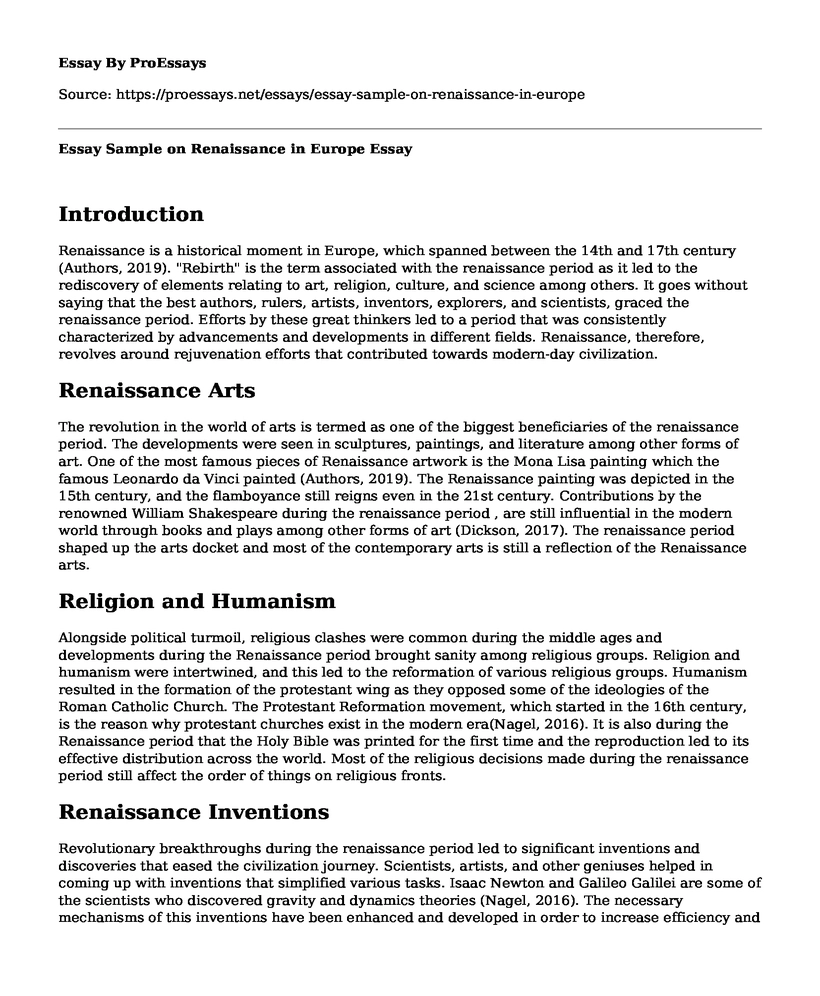Introduction
Renaissance is a historical moment in Europe, which spanned between the 14th and 17th century (Authors, 2019). "Rebirth" is the term associated with the renaissance period as it led to the rediscovery of elements relating to art, religion, culture, and science among others. It goes without saying that the best authors, rulers, artists, inventors, explorers, and scientists, graced the renaissance period. Efforts by these great thinkers led to a period that was consistently characterized by advancements and developments in different fields. Renaissance, therefore, revolves around rejuvenation efforts that contributed towards modern-day civilization.
Renaissance Arts
The revolution in the world of arts is termed as one of the biggest beneficiaries of the renaissance period. The developments were seen in sculptures, paintings, and literature among other forms of art. One of the most famous pieces of Renaissance artwork is the Mona Lisa painting which the famous Leonardo da Vinci painted (Authors, 2019). The Renaissance painting was depicted in the 15th century, and the flamboyance still reigns even in the 21st century. Contributions by the renowned William Shakespeare during the renaissance period , are still influential in the modern world through books and plays among other forms of art (Dickson, 2017). The renaissance period shaped up the arts docket and most of the contemporary arts is still a reflection of the Renaissance arts.
Religion and Humanism
Alongside political turmoil, religious clashes were common during the middle ages and developments during the Renaissance period brought sanity among religious groups. Religion and humanism were intertwined, and this led to the reformation of various religious groups. Humanism resulted in the formation of the protestant wing as they opposed some of the ideologies of the Roman Catholic Church. The Protestant Reformation movement, which started in the 16th century, is the reason why protestant churches exist in the modern era(Nagel, 2016). It is also during the Renaissance period that the Holy Bible was printed for the first time and the reproduction led to its effective distribution across the world. Most of the religious decisions made during the renaissance period still affect the order of things on religious fronts.
Renaissance Inventions
Revolutionary breakthroughs during the renaissance period led to significant inventions and discoveries that eased the civilization journey. Scientists, artists, and other geniuses helped in coming up with inventions that simplified various tasks. Isaac Newton and Galileo Galilei are some of the scientists who discovered gravity and dynamics theories (Nagel, 2016). The necessary mechanisms of this inventions have been enhanced and developed in order to increase efficiency and effectiveness. In 1440, Johann Gutenberg invented the printing press which was made of wood. Christians were one of the principal beneficiaries of the printing press which helped in printing many copies of the Holy Bible (Nakate, 2018). Leonardo da Vinci was not only a painter, but his contribution towards the first submarine is little known to the world. Cornelius van Drebbel actualized his design in 1624, and this was a significant contribution to the military forces in Europe (Nakate, 2018). Most of the machines in the modern era owe their existence to inventions and discoveries during the renaissance period.
Conclusion
Contributions from Italy, France, Germany, and Russia among other European nations put the renaissance period on the history chart. The collective effort by different countries and individuals led to the "rebirth" of key elements during the middle ages (Szalay, 2016). Italy is perceived as the home of Renaissance, and the effects spilled out across Europe in no time. Religious, scientific and artistic advancements executed during the Renaissance period are manifested in one way or another in the modern age. The intellectual contributions during the renaissance period shaped up civilization which in turn led to the existence of the modern society.
References
Authors, H. (2019). Renaissance Art. Retrieved from https://www.history.com/topics/renaissance/renaissance-art
Authors, H. (2019). Renaissance. Retrieved from https://www.history.com/topics/renaissance/renaissance
Dickson, A. (2017). Key features of Renaissance culture. Retrieved from https://www.bl.uk/shakespeare/articles/key-features-of-renaissance-culture
Nagel, J. (2016). Engelskspraklig Litteratur og kultur - The Renaissance - Science, Religion, and Philosophy - NDLA. Retrieved from https://ndla.no/en/subjects/subject:17/topic:1:184015/topic:1:184025/resource:1:88475
Nakate, S. (2018). The Revolutionary History of Renaissance Inventions. Retrieved from https://historyplex.com/renaissance-inventions
Szalay, J. (2016). The Renaissance: The 'Rebirth' of Science & Culture. Retrieved from https://www.livescience.com/55230-renaissance.html
Cite this page
Essay Sample on Renaissance in Europe. (2022, Nov 28). Retrieved from https://proessays.net/essays/essay-sample-on-renaissance-in-europe
If you are the original author of this essay and no longer wish to have it published on the ProEssays website, please click below to request its removal:
- How Alliances Started the War of World War 1 Essay
- The Use of Comic in World War II Essay
- Marsinah Accuses Essay Example
- Critical Essay on Destroy This Mad Brute
- The Black Panther Party: A Closer Look at the Controversial US Movement - Research Paper
- Communism: An Ideology for Socioeconomic Order Without Money, State, or Class - Essay Sample
- Essay Sample on Donald Slager: 30+ Years of Leadership at Republic Services







